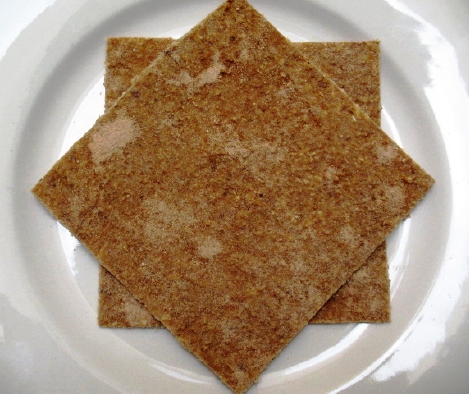
Monukka Essene Bread
Recipe at the end of this post 🙂 ( Also see Sweet Cherry Essene recipe )*Essene, (aka “manna,” is a Dr. Fuhrman-approved bread –find at end of recipe instructions* You have to go through my ramble on sprouting (and OF COURSE my going off track…slightly 😉 ) the whole-grain berries to make this bread.
Essene bread is an ancient, sprouted bread. It is much different, however, from what we consider bread today. It goes by other names — Manna bread, raw bread, etc. — all the same thing ;^) There is a brand name, “Ezekiel,” but one should read the label(s) to double check ingredients on any brands claiming “raw,” “live,” or “sprouted,” etc. breads.
It is extremely easy to make, from its most simple form — just grain, which is the original — to various additionals, flavorings, herbs, etc., for more modern palates. Some get carried away — be careful 😀 — but, by all means, do add vegetable/fruit or their pulps; or other from juicing 🙂
It should, however, be void of preservatives, sugar, salt, other unwholesome additives, and yeast. It is also very quick to make, which is a bonus. It can be made sweet or savory, both usually containing the traditional raisins or you can use other dried fruit.
It is sometimes referred to as “raw” bread, but most of the Essene breads eaten nowadays are storebought; and the majority are baked at @ 250-degrees, rendering them un-raw. One may be able to find a “truly raw” bread in some stores, as the natural and “raw-food” food movements has become more widely commercial. The packaging will indicate if it is truly “raw,” as that is a selling point; it’s usually produced by a merchant specializing in “raw food.” It will state at what temperature the breads were baked/dehydrated.
Essene breads store very well; and you can freeze them if making in bulk. Additionally, you may freeze your sprouts, too, (or even dehydrate-see pics) for use later, to make these even more convenient.
If you have never had Essene bread be aware it is not going to be like traditional bread — it is moist and chewy and has a very particular flavor from the sprouted grain. It is a “raw” flavor. The the longer and the higher temperature at which it is baked, however, the more bread-like it tastes. It is surely an acquired taste 🙂
If you try Essene bread, however, and don’t like the texture, moistness, or “rawness”; you can simply dehydrate till crunchy OR bake them at higher temperatures.
The Essene bread “doughs” benefit from sitting a while to develop flavor, just like one rests and rises yeast breads. Just don’t let it sit too long ;). This is another reason dehydrating can be tastier.
I’ve mentioned previously that I have a lot of drafts on sprouting, and other things, which I haven’t gotten to! But, since my fellow nutritarian enthusiast, Barb, (aka, Kneecap, aka Vegan Barbie) over at HealthyVegan likes a little Essene bread now and then, I figured I’d put up this post to show how easy-peasy Essene can be!
Ha…this post is sorta funny…I don’t eat grains any longer, but I do make this (and other things I don’t eat!) for family — the athletic types in the group like these better than “power bars” :). Actually, I never made Essene bread for myself, even pre-healthful eating through ETL…I was too toxic from a bad carb addiction to mess around with healthful “bread”! I was into the crusty (or chewy) topped white bread…Ugh! Okay, we won’t go there now. Even though not my thing, I hope this blog post will be helpful for those interested in healthful breads and wraps with wholesome grains. 🙂
NOTE: My recipe calls for really blending this till very smooth. Many use a juicer to get the best texture. If you have one, of course use it; but a power blender works fine. Also, my pictures do not show the Essene “dough” completely smooth, as the persons this is made for like it textured. But, generally, the batter should be smooth as you can get it.
=========
NOTE: Also remember: You can make this to your taste buds! Use any tasty grains/ingredients you wish! This is a great base from which to sprout your creativity 😉 Add whatever extras — dried tomatoes, carrot or other vegetable pulps, various nuts and seeds, vary the texture — it’s endless! Read the ingredients labels of your favorite brands and make your own for pennies.
ALSO: please remember to use very good, fresh ingredients: With so few, it really matters! Use good quality to get good quality.
Sprouting, period, is simple; so berries are no different. Here are some samples and directions:
These are Amaranth seeds: Place in a clean jar, add fresh water and soak…
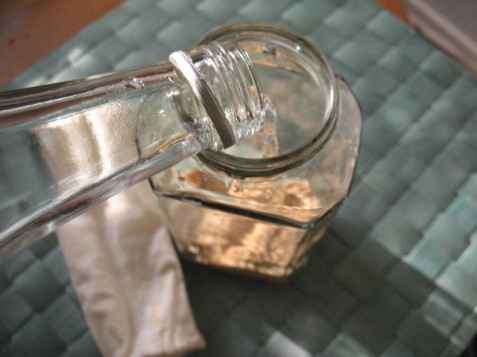
Amaranth, soaked — Isn’t it pretty! this is soaked, drained, and rinsed amaranth…
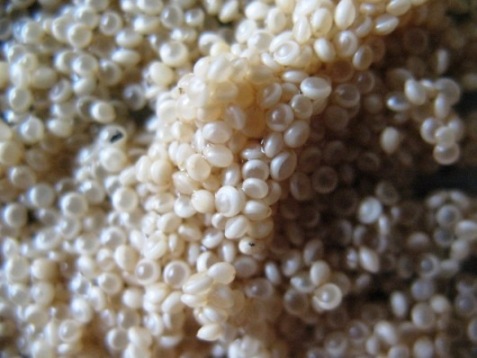
Here they are, the lovlies :). Amaranth Sprouts!
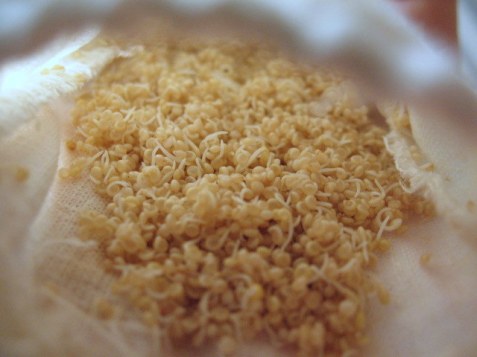
Beautiful, aren’t they? Amaranth sprouts fairly quickly, too…just fyi…Sprouted in my hand-made hemp bags :D…
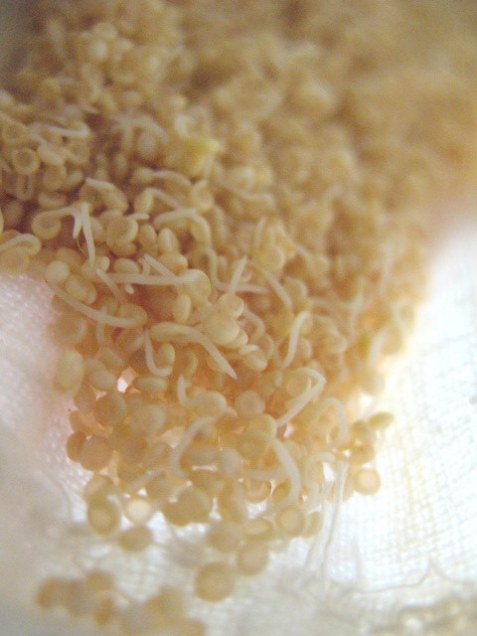
Same deal for other grains: Here is quinoa, sprouted….
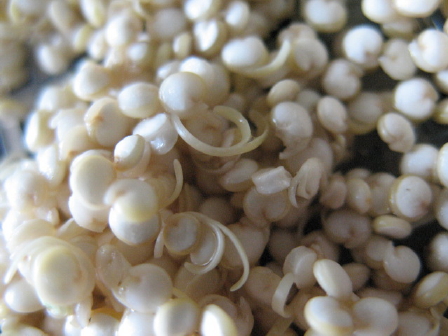
Here, their tails got longer (conditions will determine speed of growth)…
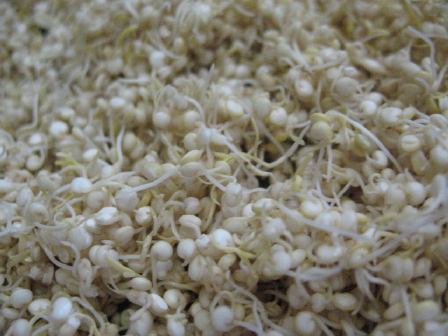
~
I sprout sometimes on my dehydrator trays! The mesh has nice sized holes to let air flow through, and, as you see, these buckwheat sprout roots grew through the bottom…
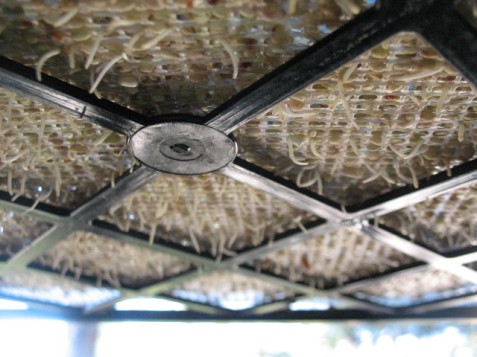
Here are the beautiful buckwheat sprouts…
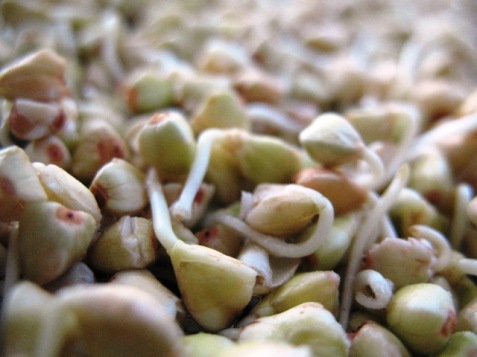
~
Essene is made with berries from the wheat family, so, whole-grain wheat, kamut, and spelt are a few.
Here are some Spelt berries, dry…
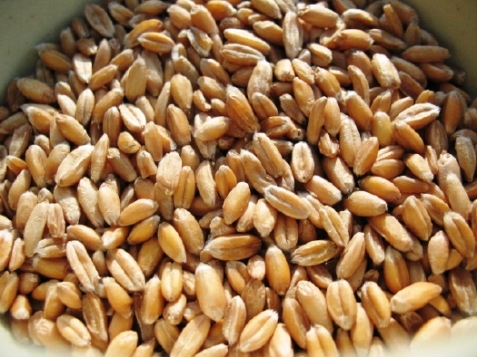
~
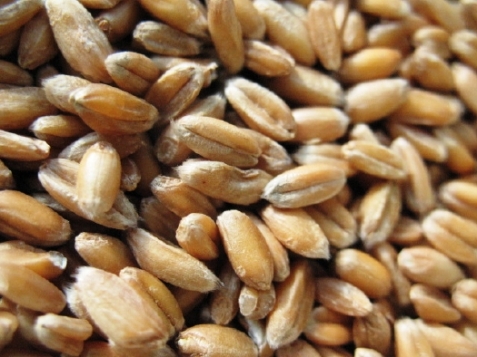
Just soak ’em…
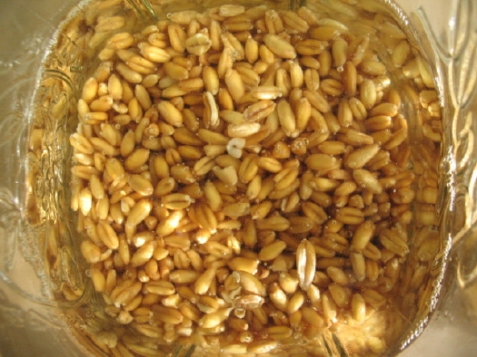
Couple days later, Voila! Spelt Berry Sprouts…
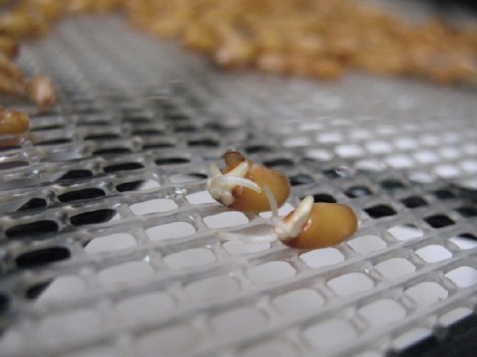
===============
Kamut Berries, Dry: These are so gorgeous. I love the color of kamut. It’s an Amber (one of my favorite colors 🙂 )..
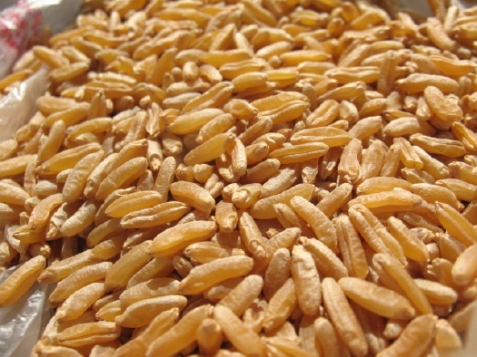
Kamut is my choice for an Essene. Combined with spelt and rye makes a delicious combo, too; and of course, you can get as creative as you wish, using any grains. Experiment, experiment 😀
Kamut is a member of the wheat family (spelt, as well). Closer look 😉 :
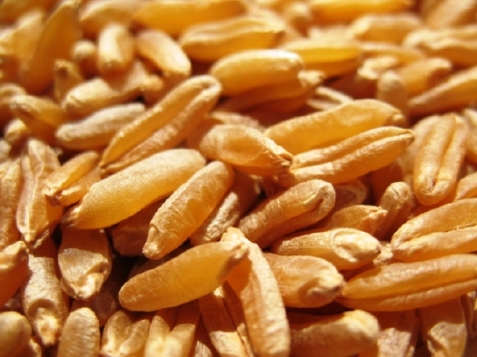
Soak kamut 6-12 hours (overnight makes it easy)…
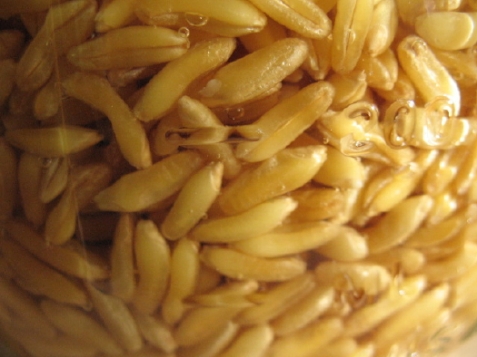
Drain, Rinse, then lay out on a tray…
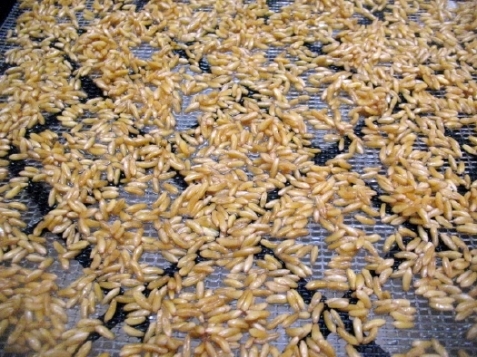
…and rinse and drain them every 8-12 hours (usually about 2-3 times) (minding weather conditions)
~
Kamut Berry Sprouts Day 2
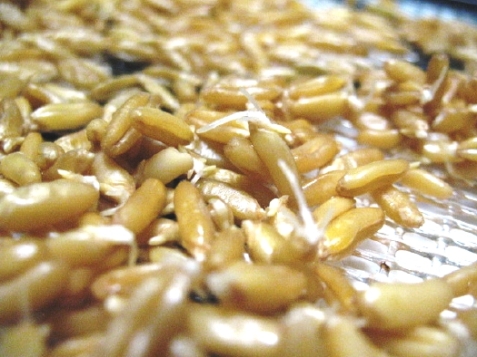
For Essene Bread, where you stop growing is debatable: Some say the tail should be twice as long as the berry; others say just as long as the berry, or equal in length to the berry. Grain sprouts get bad-tasting when sprouted too long; they are best, and sweeter at a small tail. You decide. Taste test. My advice is to go with length of the berry or 1/4-inch tail.
Okay, here are the tails at Day 2 (in California winter time; summer, these grow faster and would be longer) …
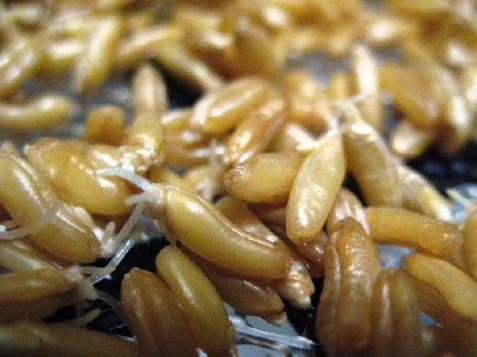
Rye Berry Sprouts: These came out perfect. As you can see, I did them in a jar. Small amounts are fine this way….
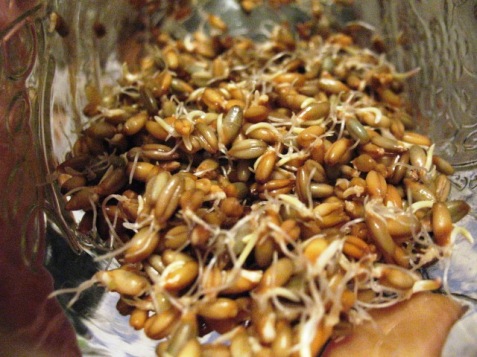
———–
Jar method:
Soak (rinsed and drained) seeds/berries in a clean mason jar. Drain and rinse every 8 hours or whatever is specified for the particular seed you’re growing. If you have a sprouter lid like this one…
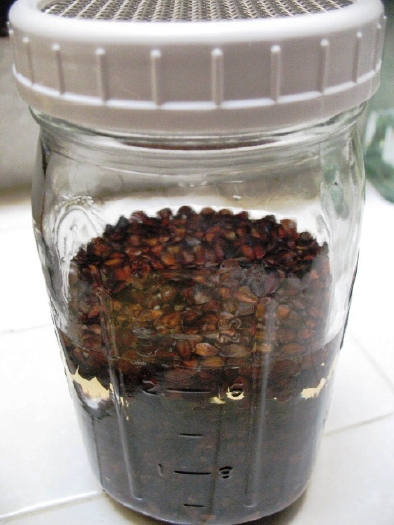
Use it. (Sprout People have nice ones (the one above), which I prefer; I like the plastic bands — the metal rusts).
If not, some clean cheesecloth (found at any market) works great…

(The above are broccoli sprouts, which are obviously not what I’m discussing here; but the cloth top is to demonstrate; )
Lay it on it’s side so it continues to drain, has more space to breath, and is not sitting in a puddle.
Not the best pic…it should be facing down slightly more than in this pic to drain, as opposed to strictly on its side, if that makes sense…It should be at an angle…
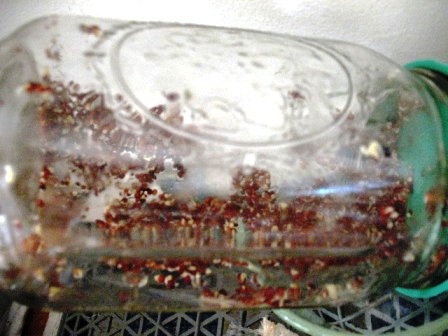
I have put them in my sink dish rack to drain; that works great too 🙂
Here’s some more good news: You don’t need a dehydrator tray (though, it’s nice and roomy) nor a jar and lid; you can sprout in a colander, preferably with lots of holes. Of course you still need to soak them somewhere — a bowl or any-‘ol jar will do.
While sprouts are growing, you must place a towel or newspaper over it in order to keep out light. Sprouts need darkness to grow (same for the jars). Procedure for green sprouts requires another step where it bathes in sunshine; but for grain berries, for our purposes, it only grows a small tail and will not grow to a green.
This is one of those ubiquitous steamer inserts! It has lots of holes for good air flow. It’s not a lot of room, but, if you’re making small amounts it works very well. These are ryeberries…
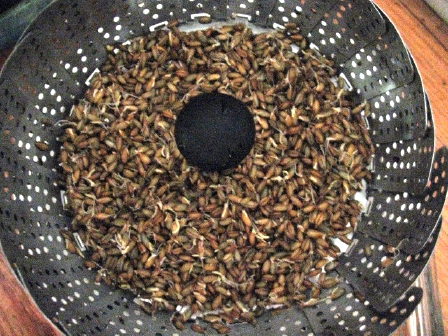
To demonstrate that this does work, here are some pics of sprouts I grew to green on the steamer — alfalfa sprouts…
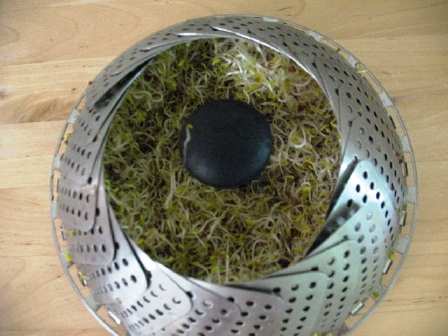
…and some clover sprouts!

So, you don’t really need fancy equipment 😉 . Especially, if you’re not growing loads (like I do!) Look around your home and you may find something similar to use.
For more on jar sprouting, visit this page at SproutPeople.
Okay, getting off track…I LOVE MY SPROUTS!!! 😀
~
Back to the Essene Bread…
Choose your berries and sprout, OR you can buy some in the refrigerated section of some markets (if you have a hippy-vitamin store they sometimes have some in the fridge sections too 😀 ).
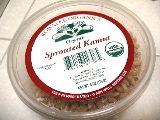 The pic to the left is a 6-ounce container of organic, sprouted kamut from Whole Foods; it cost $1.99 (a rip when you consider how VERY inexpensive it is to buy your own organic grain and sprout!)
The pic to the left is a 6-ounce container of organic, sprouted kamut from Whole Foods; it cost $1.99 (a rip when you consider how VERY inexpensive it is to buy your own organic grain and sprout!)
=
So organic Kamut, sprouted, for this recipe 😉
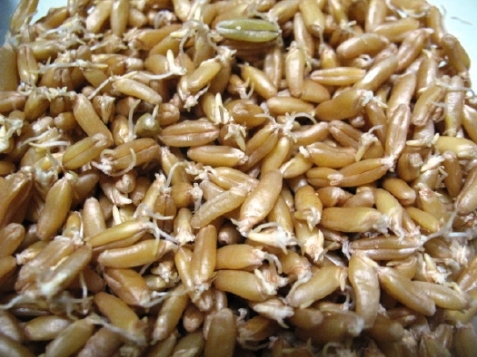
Look for these delicious Monukka raisins…
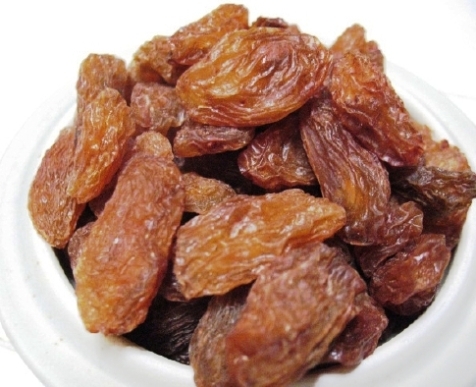
Pecans…
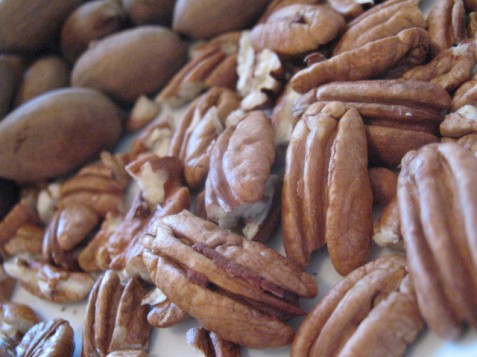
Some Vanilla…
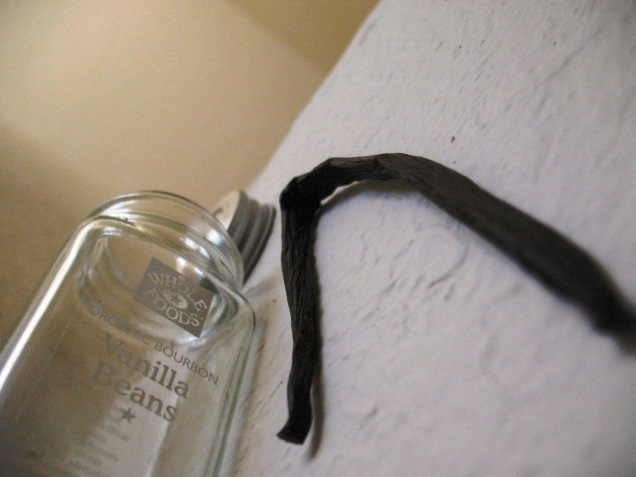
…don’t worry, use extract 😉
OPTIONALS:
Date Sugar: 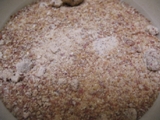
Cinnamon/Spices
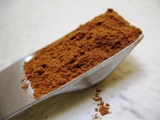
OR a Combo: nuts/seeds, spices, dates, ground together (coconut) 😉
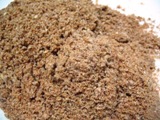
~ *** ~
Just put berries, raisins, vanilla (not nuts or topping!) in the blender…
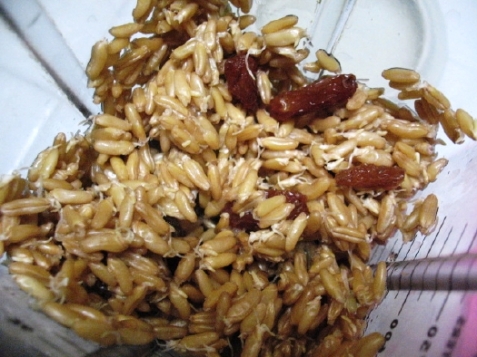
Pulsing helps draw it in…
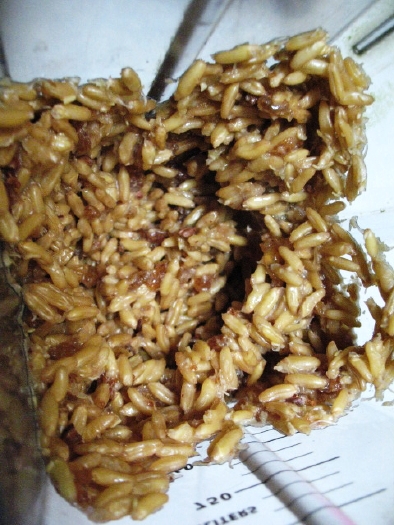
Use your tamper or stop blender and use a spatula to get it moving…
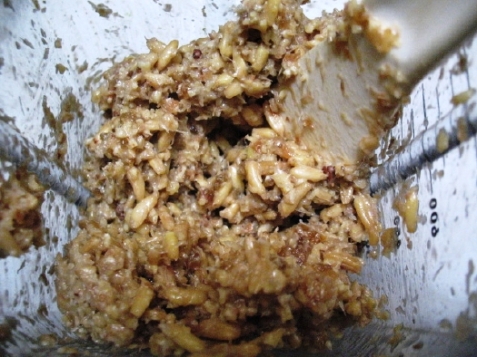
Coming along 🙂
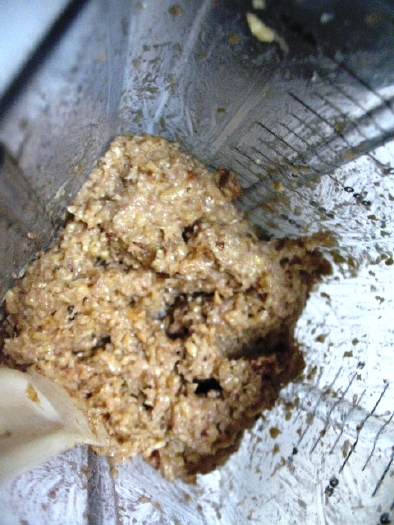
I stop here for texture; however, you should let it get to smooth as possible…
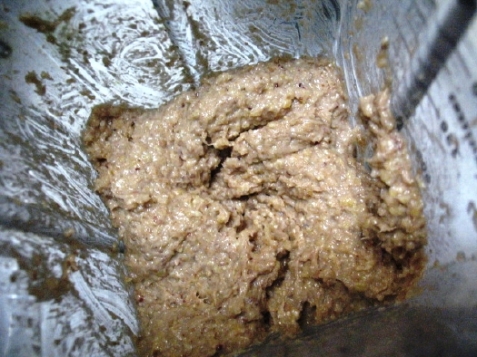
…and stir in by hand the finely chopped or ground nuts.
Spread onto parchment-lined dehydrator tray…
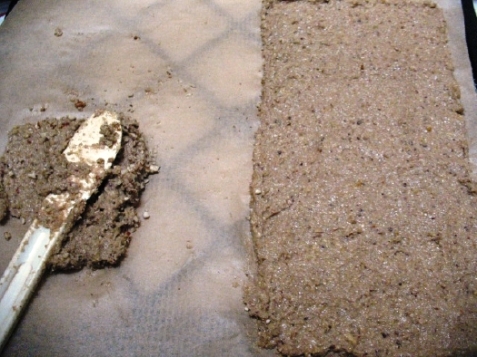
~
Sprinkle with topping, if using…
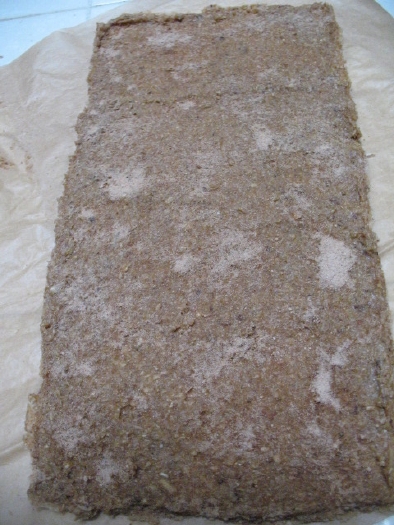
`
Dehydrate or bake…
~
~ *** ~
The Recipe:
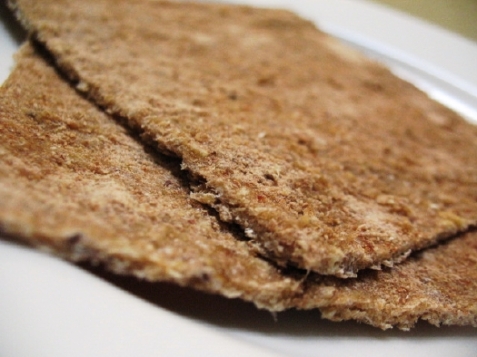
My Monukka Essene Bread, (basic, sweet version)
This is rated at light-medium-sweetness. For lighter sweetness, omit the dates (in the/or the) topping.
It has the intended chewy texture of classic Essene bread; however, you can adjust the texture to preference.
This is a raw-food Essene, but you may bake it at as low a temperature as you please in your oven, not to exceed 250-degrees to be considered an Essene Bread. You may, of course, do as you wish 🙂
Vary the textures for variety; see notes.
6 ounces sprouted, organic Kamut Berries, whole (@ 1 1/2 C sprouted berries)
1/2 tsp Vanilla Extract
1/2 C Monukka Raisins, soaked and drained (or good-quality, super-tasting, sweet golden raisins (OR Dates, pitted)
Blend in a power blender till VERY smooth. You will see the gluten makes it a sticky dough. Do not add water, unless absolutely necessary; the grains should have enough, and the fruit as well.
Stir in by hand @ 1/4 C or more of finely chopped, minced, or ground Pecans
~
Spread evenly onto sheets to desired thickness.
You can sprinkle with a topping if you choose.
Dehydrate to desired texture.
The above, took 2 hours in the dehydrator at maximum heat — 155-degrees — to have a bendable texture; so good for a wrap or sandwich (or cookie). The thicker one took about 3 hours (see pics below).
I left the crackers go @ 6 hours — again, depends on how thickly you spread the dough and what texture you like. To test, just take out a piece and let it cool. Then taste for texture.
Note: If decide you should have added a topping to the recipe, but didn’t, you can still add it: Just spritz the top of your bread with a water bottle and then sprinkle with date sugar, date-nuts/seeds, or cinnamon-date sugar. Give it another light spray to make sure it sticks. Then, simply pop it back in to the dehydrator for a bit till dried. Voila! Fixed 🙂
Cinnamon Date Sugar:
- 1/4 C date sugar
- 3/4 – 1 tsp Cinnamon, ground
Mix thoroughly. Store in a well-sealed.
Sprout People has a good suggestion: sprinkle the pan with seeds or nuts to keep it from sticking. Sesame seeds are a great choice! Or dip your dough in a bowl of seeds to cover all sides. I’d just sprinkle them on top.
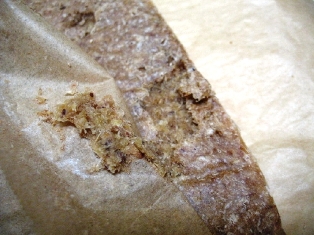
I just use parchment and it peels right off when cooled. The above pic shows what happens when you don’t let it cool first 🙂 Use something because it will stick to the plastic mesh sheet of a dehydrator and not be easy to release. Alternatively, some dehydrators provide solid sheets for making fruit rolls and other sticky things; you can use that.
I’ve also used a silicone baking sheet in a pinch. Works great. There are small sizes available now, too. “Silpat” is the original, I think.
Temperature is up to you. You can make it “raw”; or bake it at a low temperature in your oven — the higher the temp, the more “enzymes” will be killed. (To avoid acrylamide formation, I would keep it under 248-degrees). It’s up to you. The ones in stores, unless specified, are usually heated above 250-degrees.
Oh, and by the way, if you want it “raw,” you should actually start off the temperature as high as it goes for at least the first 15 minutes to half an hour. Pre-heating the dehydrator helps, too. The reason, is that the wet loaf will not be anywhere near the high temperature for a while (especially the inside and the center); so it will still be raw. You also avoid it rotting! You won’t like that taste 😉
So you see the advantages of making these into bread-like slices or like wraps, such as lavash or pita — one being that the short dehydrating/cooking time doesn’t allow it time to get bad 🙂 — amongst other advantages. I never understood the little thick loaves…too raw on the inside and just too gummy. But that’s just me 🙂 You can make little loaves, if you wish; just not too thick (high) and watch for fermentation by taste testing.
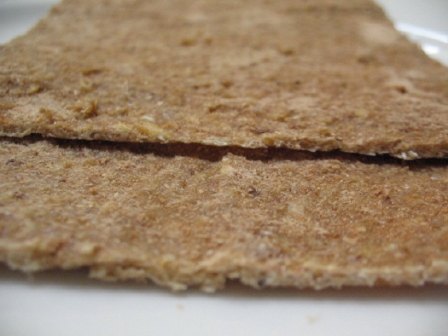
~ *** ~
Here is a picture of the thicker layer I mentioned…
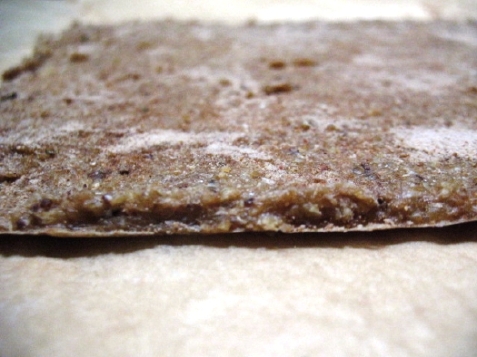
You can cut trim the sides to make it more even…
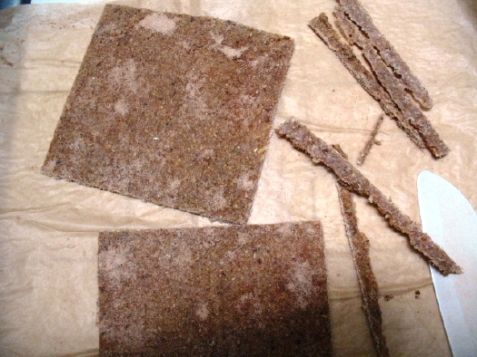
Make little bread sticks 🙂 Or dry for extended periods to make crackers…
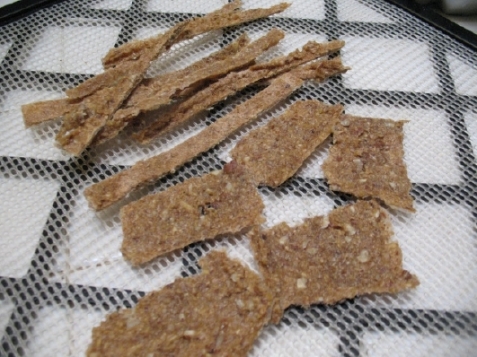
…or till desired texture (to get a cookie-like texture and shape) 😀
* I asked Dr. Fuhrman if raw, dehydrated Essene bread is safe for children (and if dehydrating is okay and if baking is okay); his response:
“I don’t see any problem with some of that healthful bread for children after one year of age. Any way you prepare it is okay.”
So Good News! 😀 Another DPYC recipe!
~ *** ~
Here are pictures of kamut berries which I had sprouted, then dehydrated for long storage…
Properly (thoroughly) dehydrated grain sprouts lasts indefinitely…
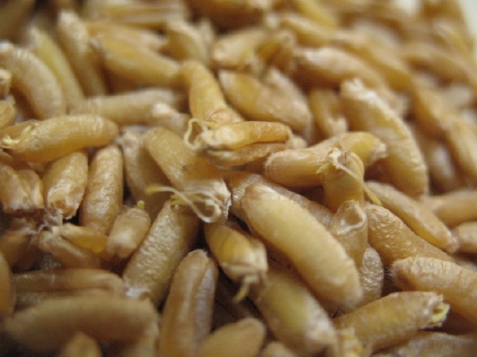
I’ve stored them for years, and they are still excellent. Good for your earthquake kit or other kit custom to your location.
Also a possible traveling food…
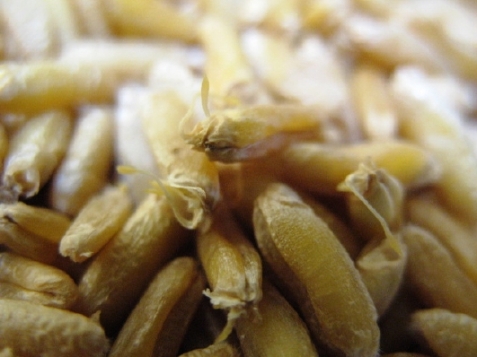
Sprouted grain, by the way, is higher in protein and enriched through the sprouting process; so it it has lower starch and less carbohydrates.
To dehydrate, take care to do so at a very low temperature to preserve its nutritional value, but also to not burn the delicate little roots. Do not put them in the dehydrator wet; rinse them one last time and let them complete their final sprouting for the 8-12 hour period. Then pop them into the dehydrator at @ 90-degrees to dry. It won’t take long at all. Bite or cut through one or two to make sure it’s dry throughout. Store in a tightly covered glass container.
** ~ **
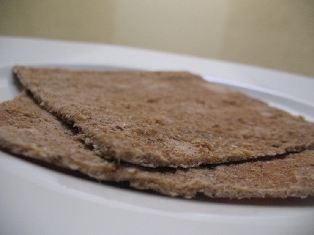
So, barb, here’s the skinny:
Soak, drain, lay out to sprout and rinse every 8-12 hours some kamut or spelt berries till their tails are @ 1/4″
Dump ’em in the blender with some Monukka raisins and vanilla.
Blend, add nuts, Spread, Dehydrate or bake.
Done.
Voila!…Barbie Bread 🙂
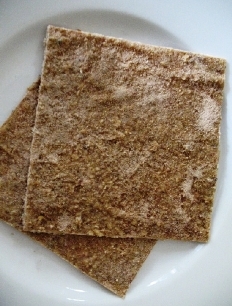
~~
Any sprouting question, just ask! I’m not an expert, but I’ve done lots…some of it documented here on my blog, so take a look around at posts from last year, and you’ll find lots of info; but absolutely feel free to ask. I’ve done some microgreens, and lots of sprouts 😀
Strix

 *
* Algaes make your smoothies a deep rich dark green 😀
Algaes make your smoothies a deep rich dark green 😀Cue “6 Million Dollar Man” theme OR… 😉

















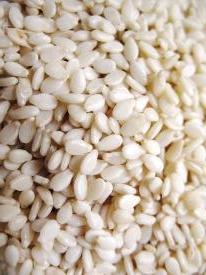

 Hulled sesame seeds have their outer shells removed. They are sometimes referred to as just sesame seeds or as “white” sesame seeds. This makes the smoothest butter, or “tahini,” and is what is most often found creamed, jarred in stores.
Hulled sesame seeds have their outer shells removed. They are sometimes referred to as just sesame seeds or as “white” sesame seeds. This makes the smoothest butter, or “tahini,” and is what is most often found creamed, jarred in stores. Unhulled sesame seeds maintain their shells. Referred to as “brown” sesame seeds or “whole” sesame seeds. More nutritious than white, they also carry a bit of bitterness from their shells. Rinsing and draining alleviates much of that tannic flavor.
Unhulled sesame seeds maintain their shells. Referred to as “brown” sesame seeds or “whole” sesame seeds. More nutritious than white, they also carry a bit of bitterness from their shells. Rinsing and draining alleviates much of that tannic flavor.
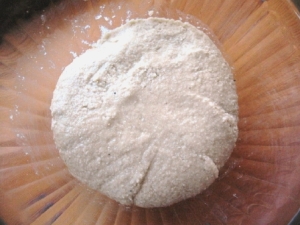
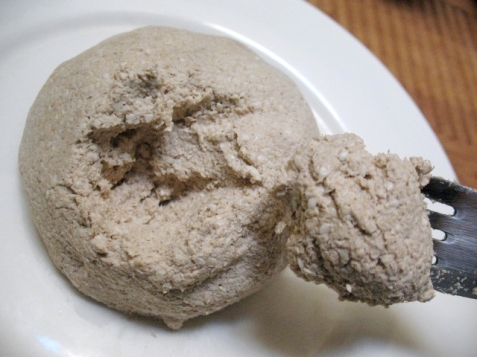
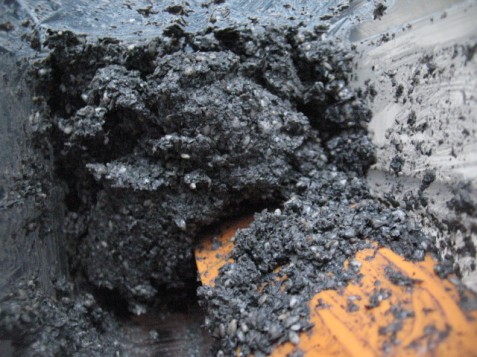
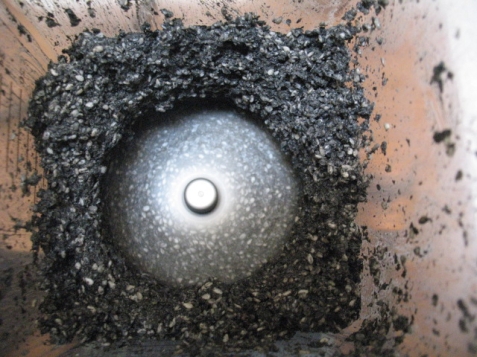
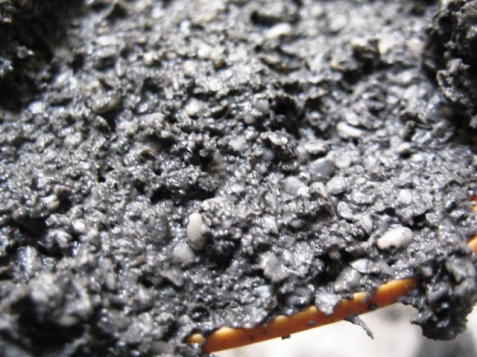
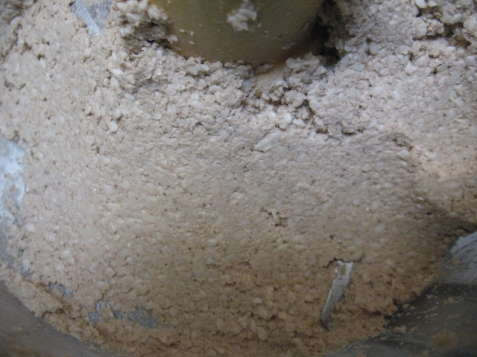
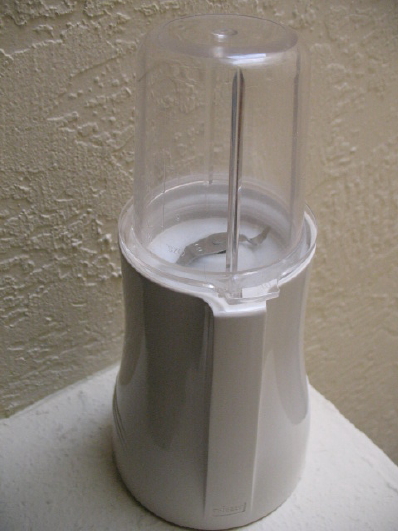
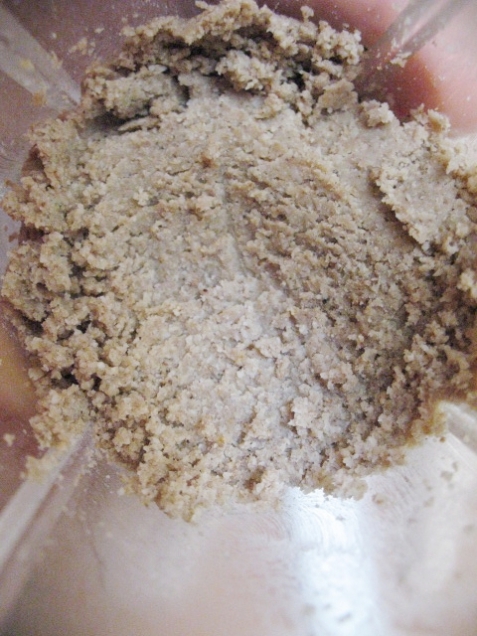
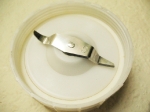 ~ Be sure to use the flat blade for buttering. ~
~ Be sure to use the flat blade for buttering. ~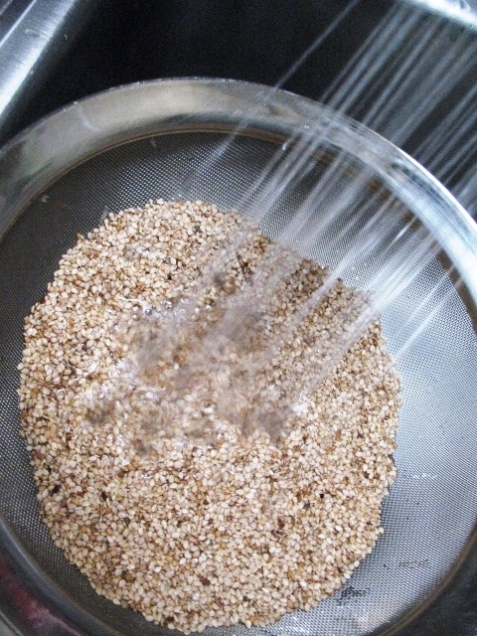
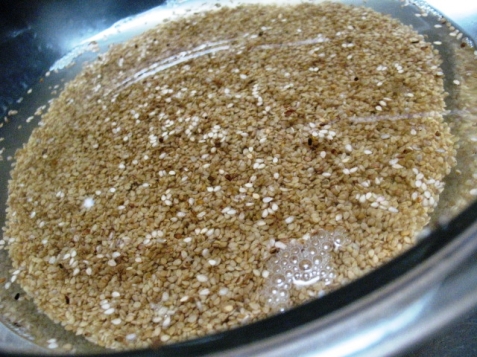
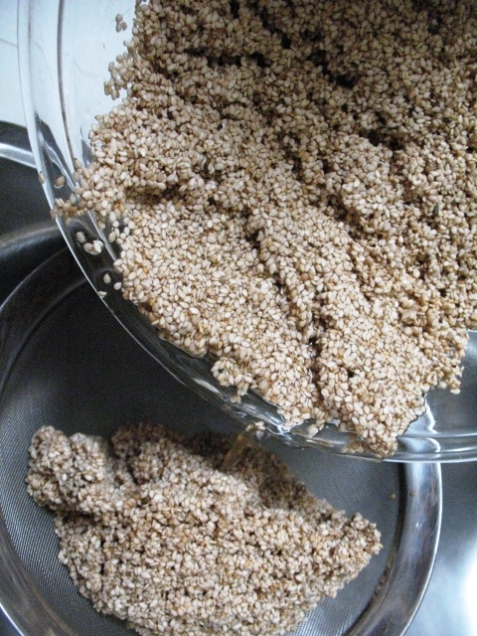
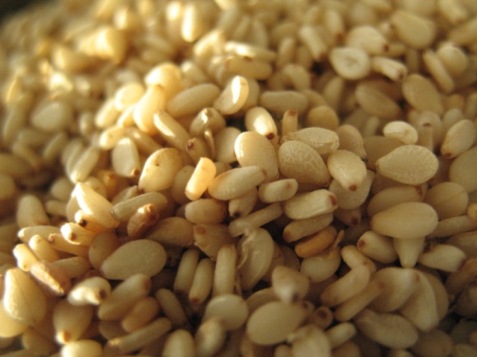
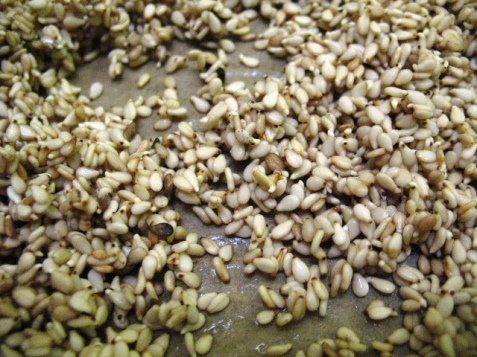
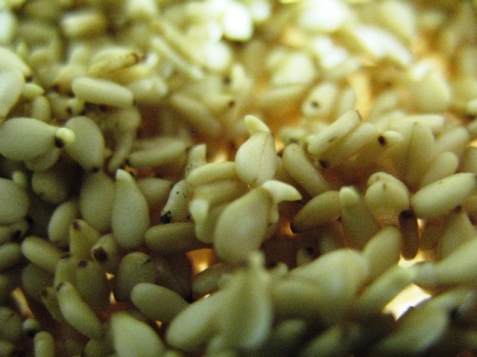

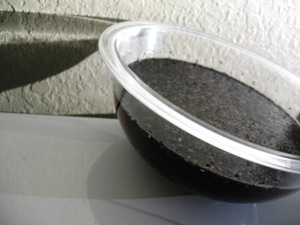
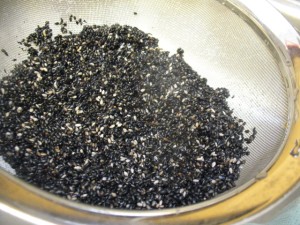
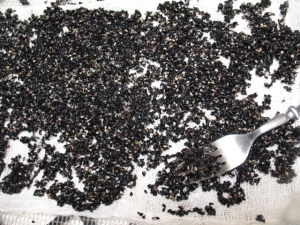
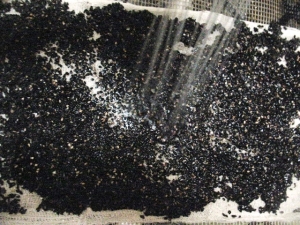
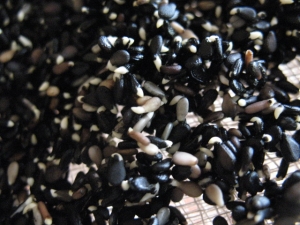
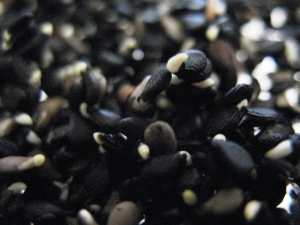
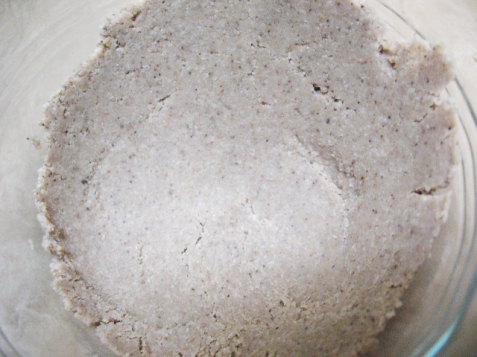
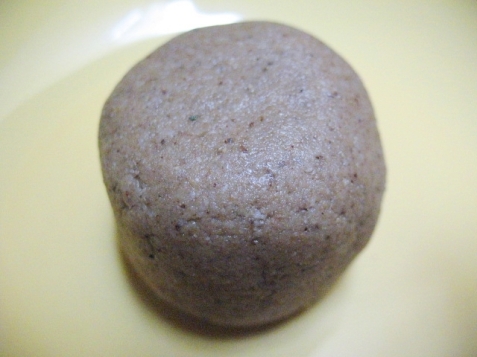


























 The pic to the left is a 6-ounce container of organic, sprouted kamut from Whole Foods; it cost $1.99 (a rip when you consider how VERY inexpensive it is to buy your own organic grain and sprout!)
The pic to the left is a 6-ounce container of organic, sprouted kamut from Whole Foods; it cost $1.99 (a rip when you consider how VERY inexpensive it is to buy your own organic grain and sprout!)
























































































